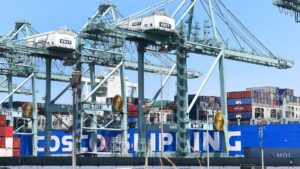There’s a lot for investors to watch as stocks inch towards all-time highs.
But the “big unknown” that matters most is the ongoing trade dispute between the United States and China, particularly as it relates to the U.S. economic layout, says Benn Steil, director of international economics and senior fellow at the Council on Foreign Relations.
“We are seeing some softening in the labor market. We are seeing a weakening in earnings,” he said Thursday on CNBC’s “Futures Now.”
“The big unknown — and Chairman Powell keeps emphasizing this — is trade, the trade war with China,” Steil continued. “And we’re not going to get much more clarity on that until next month, and I think that’s going to be the big factor going forward in the Fed’s decision-making about whether to cut rates further.”
U.S. and Chinese trade officials met in Washington, D.C. on Thursday and Friday to lay the groundwork for higher-level negotiations scheduled for early October.
But those talks likely won’t yield the progress investors hope to see, Steil warned.
“I think the Chinese are digging in for a long war here,” the economist said. “I don’t think you’re going to see significant concessions from the Chinese side before the next election in November 2020. You may see some token cosmetic concessions from both sides as they try to palliate the market, but I think we’re a long way away from resolution of the fundamental differences between the U.S. and China.”
That makes the job of the Federal Reserve — which cut its benchmark interest rate for the second time this year on Wednesday — increasingly difficult as it decides how best to support the U.S. economic expansion as other global economies slow, Steil said.
“It’s clear that all the major banks — the Federal Reserve, the ECB, the Bank of Japan — [are] all rowing in the same direction” when it comes to monetary policy, Steil said.
“The big difference at the moment is that the Federal Reserve is still comfortably in the territory of conventional monetary policy,” he said. “[With] the ECB and the BOJ, in contrast, negative interest rates and quantitative easing [is] much more difficult territory to navigate.”
But while the Fed is unlikely to let U.S. rates dip into the red, more quantitative easing — the process of central banks buying assets from their domestic markets to spur economic activity — isn’t off the table, Steil said.
“I don’t think we’re going to see negative rates as a policy tool. In fact, [Fed Chairman Jerome] Powell has poured cold water on that. But we could very well see more QE,” he said. “The Fed clearly has no intention of resuming its balance sheet shrinking. I think Wall Street would welcome a foray into QE as long as they didn’t see it as a sign that the Fed was predicting an imminent recession.”
And, at the end of the day, the outlook on U.S.-China trade will be a huge determinant in what comes next, Steil said as he looked ahead to the next week of the United Nations General Assembly’s 74th annual session.
“We’ve got some front-burner issues, in particular the conflict between Iran and Saudi Arabia, but there’s that bigger issue that looms in the background: what is the future of U.S.-China relations?” he said. “It’s clear that it’s not just deteriorating on the economic front, but it’s deteriorating on the broader diplomatic and security front, and that’s the sort of issue that I expect people to be focusing on in the corridor.”
Disclaimer

